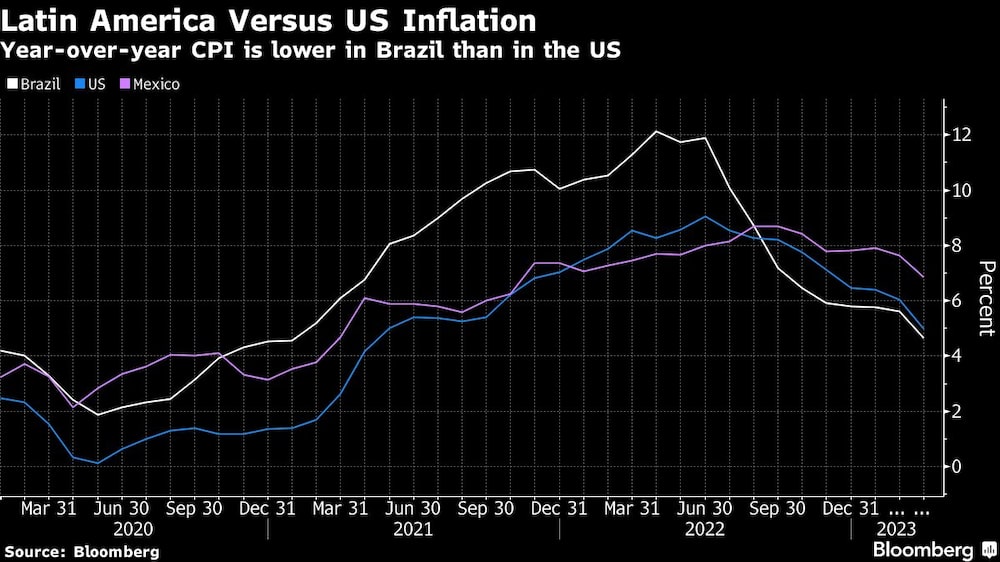Bloomberg — With inflation easing around the world and many central banks nearing the end of their interest rate hikes, a growing chorus of investors say the best place for bond buyers to juice returns is in emerging markets.
The asset class stands to benefit from benchmark rates that are higher — and inflation rates that in some cases are lower — than in the US. In Latin America, central banks acted quicker than the Federal Reserve when price pressures started bubbling up, ultimately tightening more.
Now, with the Fed expected to cease raising rates soon and pivot to easing later in the year, the US dollar is sliding, paving the way for central bankers in the region to follow suit. That sets up a potential windfall for investors holding local-currency bonds.
“A structural allocation to local markets is one of the best ways to express your view in Latin America as the dollar weakens,” said Mauro Favini, a senior portfolio manager at Vanguard Group Inc. who helps oversee the firm’s $2.5 billion Emerging Markets Bond Fund.
“Once the Fed starts cutting, it allows Latin American central banks to follow as there is less risk of local-currency depreciation as the dollar falls,” he added. “There is much more scope for capital appreciation in Latin American bonds than the US.”

Consumer prices have started to fall significantly across emerging markets in recent months, with March data showing annual inflation hitting a 13-month low of 6%, compared to 6.9% in February, according to a provisional estimate from Capital Economics.
For some of Latin America’s largest countries, cooling inflation is the result of decisions to move early and aggressively to raise rates. Brazil, which began to tighten a full year ahead of the Fed and has hiked its policy rate to 13.75%, saw consumer prices advance 4.65% in March, the least since January 2021.
Mexico, the region’s second-largest economy, saw inflation increase 6.85%, the softest since October 2021, though still above the 5% pace in the US.
Slowing price increases and a weakening dollar have been a boon for domestic assets this year. Local-currency Latin America government bonds have returned 12.5% in 2023, well ahead of the 3.4% average return for hard currency debt from the region, according to data compiled by Bloomberg.
“EM local has done very well year-to-date on the back of the strong disinflation theme,” said Ilke Pienaar, head of emerging-market sovereign research at Pinebridge Investments. “We still think there is opportunity left, and we forecast healthy returns for local markets this year.”
Despite the positive inflation trends, traders who expect policymakers to quickly begin cutting rates may be in for disappointment, said Mario Castro, a senior fixed-income strategist at BNP Paribas in New York. “At the end of the day, central banks are likely to be cautious before starting to cut to ensure that inflation will converge to the target,” he said.
One reason: While headline inflation is trending lower, core inflation has been stubbornly high in Mexico, Chile and Colombia, and has come down only gradually in Brazil, said Joel Virgen Rojano, senior Latin America strategist at TD Securities.
“There is still high uncertainty regarding the future inflation path,” he said.
In Mexico, central bankers have signaled they expect to keep rates high for years in order to hit their 3% inflation target. Luis Gonzali, a money manager at Franklin Templeton, said he holds both nominal notes and inflation-linked bonds but is overweight on linkers due to the outlook on core inflation.
“Mexico is having more trouble than US regarding core inflation,” he said.
In other markets, Virgen Rojano said easing cycles should begin in the second half after central banks have “more evidence of economic weakening and further disinflation.” There’s ample room for cuts, he added, which creates opportunities to receive rates in the region for the rest of the year.
“You have an immense amount of compression to come from a rate cutting cycle, and we like the front part of the curves in Latin America,” Vanguard’s Favini said. “Our approach to managing the portfolio is asking ‘what is the asset class that delivers the best bang for the buck?’”
WHAT TO WATCH
- The People’s Bank of China is expected to keep its one-year policy rate steady on Monday, leading commercial banks to follow suit when they set their prime lending rates later in the week, according to Bloomberg Economics.
- Indonesia’s central bank will extend its rate pause, according to economists surveyed by Bloomberg, amid the rupiah’s resilience.
- Brazilian factory output will be in focus. President Luiz Inacio Lula da Silva’s government is also expected to send its proposal for a new fiscal rule to Congress on Monday
- Bloomberg Economics expects the minutes from Chile’s central bank’s April meeting to show policymakers are comfortable delaying any cuts until it’s clear that inflation is on track to fall to 3% over a two-year horizon.
Read more on Bloomberg.com



